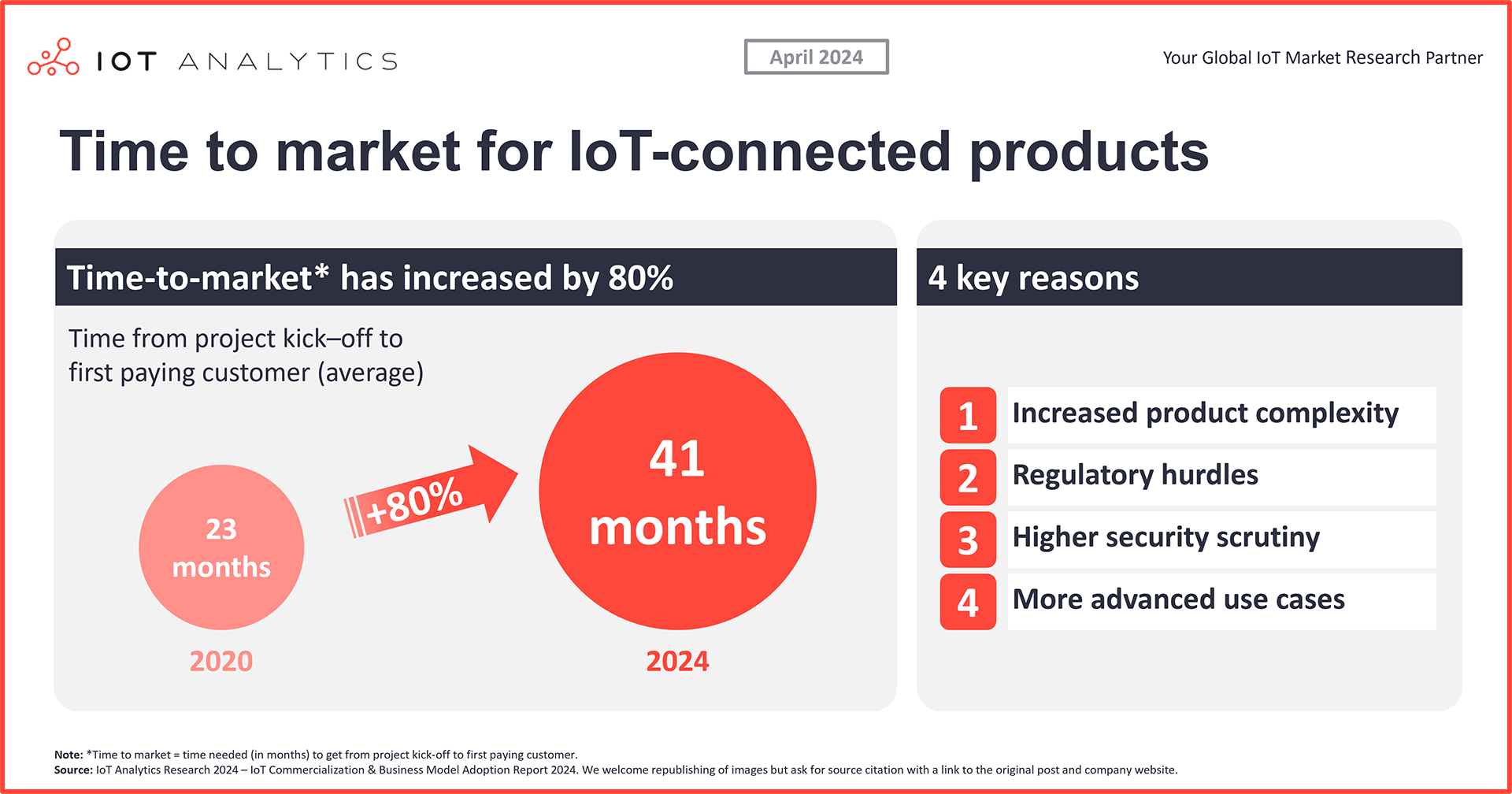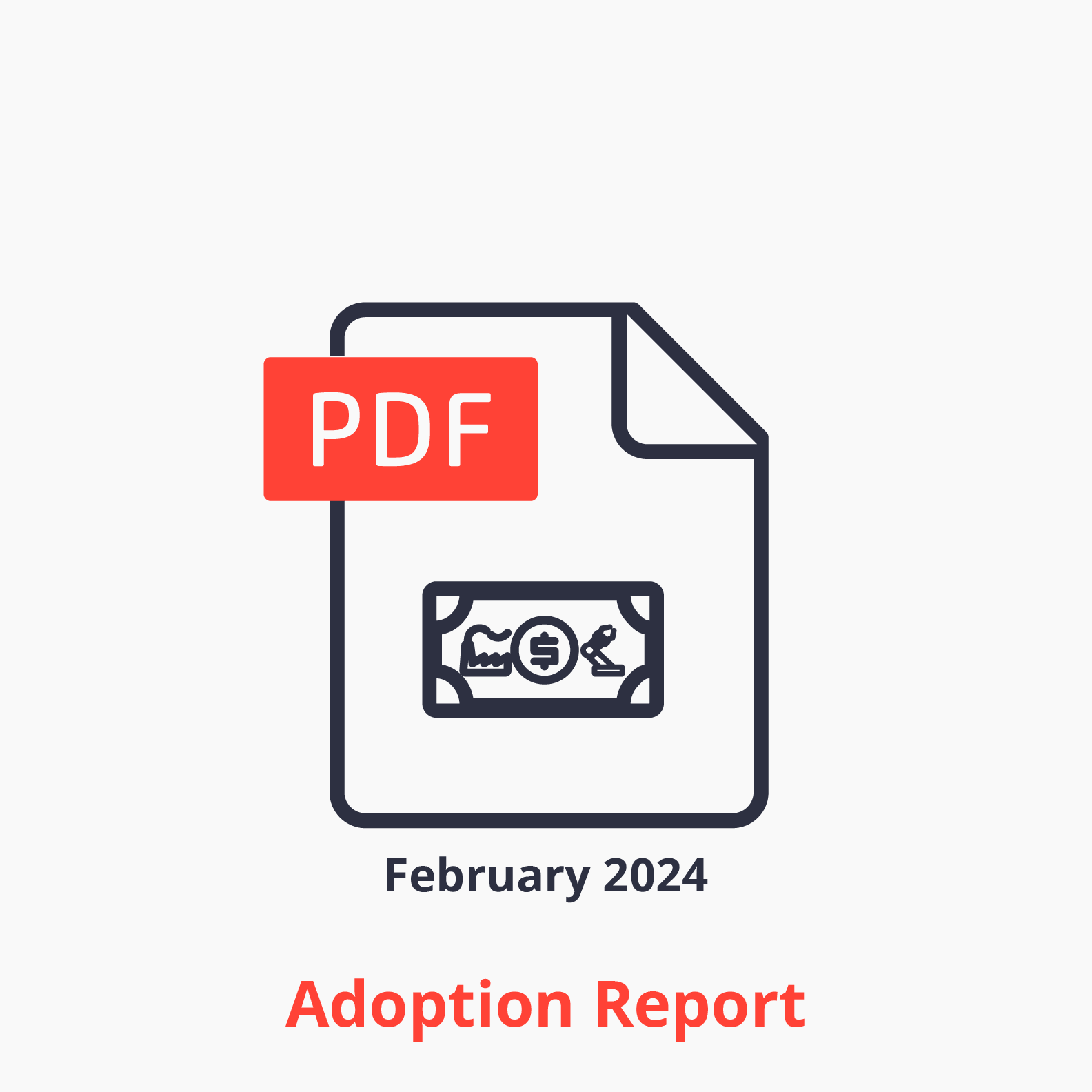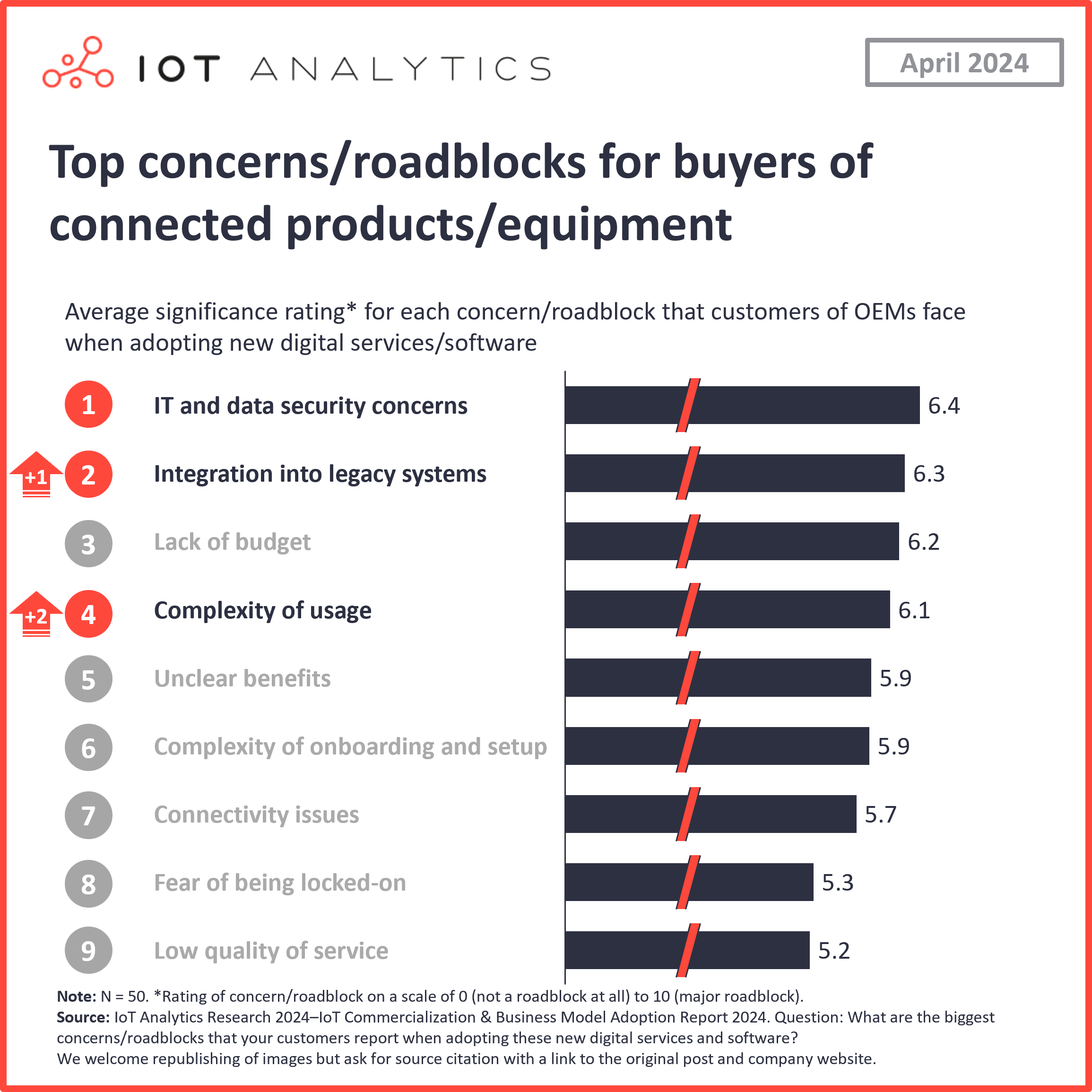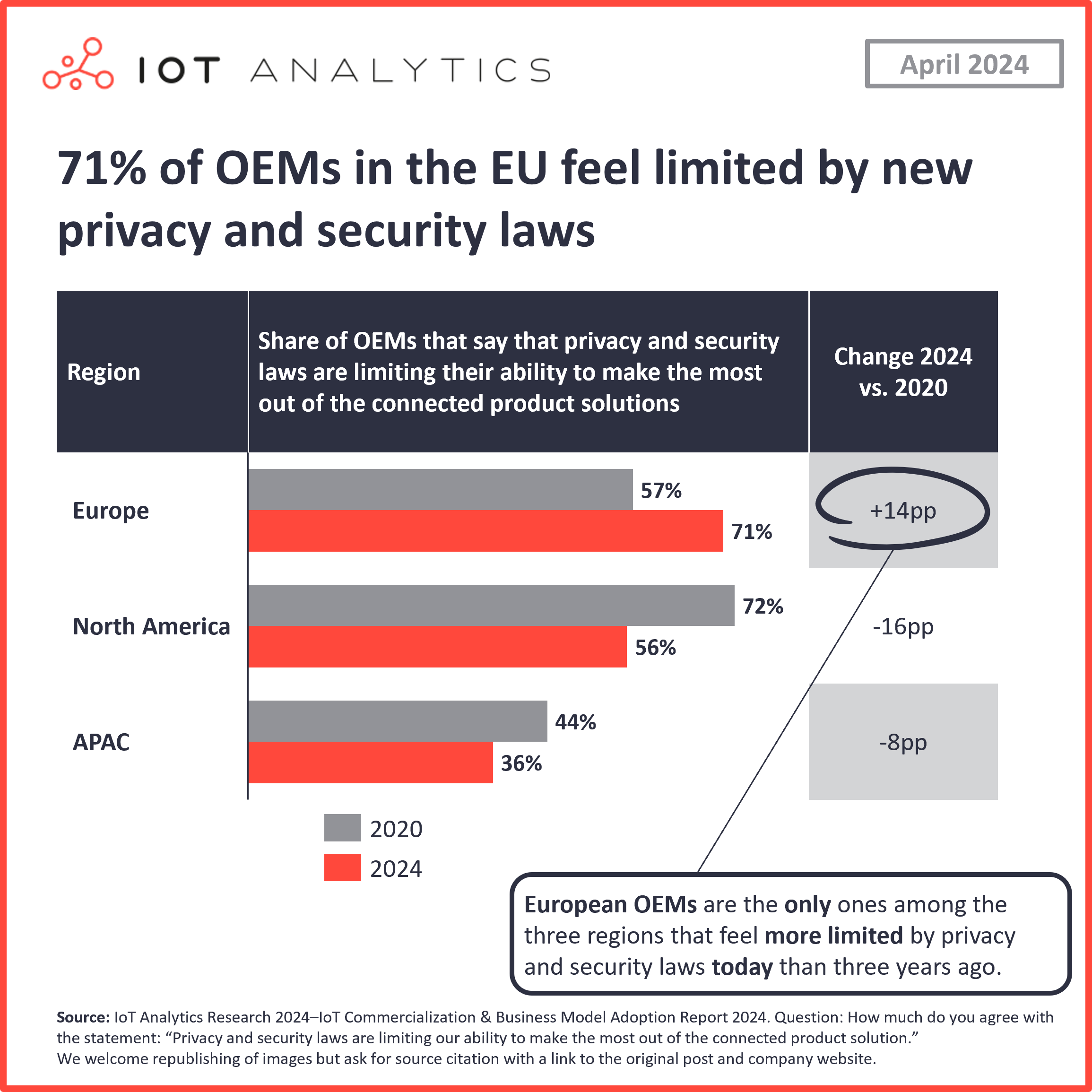
In short
- In 2023, OEM time to market for connected products—from project kick-off to the first paying customer—averaged 41 months, an 80% climb since 2020, according to the 206-page IoT Commercialization & Business Model Adoption Report 2024.
- Though this appears counterintuitive given advances in IoT technology, increased market knowledge, and a decreased historical learning curve, the research identified four factors contributing to this increase in OEM time to market:
- Product complexity
- Regulatory hurdles
- Higher security scrutiny
- More advanced use cases
Why it matters
- Understanding the complexities of getting products to market for OEMs and setting realistic expectations are crucial for the success of the IoT-connected products market.
OEM time to market climbed 80%
OEMs take an average of 41 months to bring connected products to market. According to a survey of 100 senior executives and department leaders at OEMs, queried as part of the IoT Analytics’ 206-page IoT Commercialization & Business Model Adoption Report 2024, companies took an average of 18.5 months to go from project kick-off to proof of concept, with business case development and stakeholder alignment taking a large chunk of the time. It then took 22.8 months from proof of concept to the first paying customer.
This 41-month time-to-market period represents an 80% increase from 2020. IoT Analytics research on this topic in 2020 found the average time to market was 23 months. The 80% increase is seemingly problematic for the success of IoT initiatives, and it may appear counterintuitive to most readers, mainly for the following three reasons:
- Rapid technological advancements: The swift advancement in IoT technologies would suggest faster technology development and deployment. It is reasonable to assume that improved tools and hardware would shorten the journey from project kick-off to market.
- Increased market knowledge: With more industry professionals and consumers becoming knowledgeable about IoT, this should increase awareness and, in theory, lead to quicker project cycles and market adoption.
- Historical learning curve: Based on past tech trends, one would expect the maturing IoT sector to benefit from earlier experiences, leading to more efficient processes and reduced time to market.
Thus, this begs the question: Why was there such a drastic increase in three years? The IoT commercialization report shares four contributing factors based on discussions with experts in the field working at connected-product OEMs.
Note: In a previous article on OEM commercialization, IoT Analytics shared four steps that, based on research, help make business models successful.
Prominent examples of OEMs that have innovated their business model and subsequently scaled to hundreds of thousands or even millions of connected devices at this point include:
- BMW, with over 20 million connected vehicles on the road worldwide.
- John Deere, with over 500,000 connected agriculture- and construction-industry machines in the field.
- Schindler, with over 500,000 connected elevators around the world.

This article is based on insights from:
IoT Commercialization & Business Model Adoption Report 2024
Download a sample to learn about the in-depth analyses that are part of the report.
Already a subscriber? Browse your reports here →
4 factors contributing to greater OEM time to market
1. Project complexity
IoT projects’ complexity has extended development cycles due to advanced technology integration. Features like additional sensors, local data processing, advanced network architectures, and integration with legacy systems all add layers of complexity to the connected product development process. A few years ago, many OEMs were measuring just a small selection of different data points of the equipment, often in spaced-out intervals with basic dashboarding functionality. However, they are now often doing the same with more sensor values on second or even milli-second intervals and adding a number of sophisticated applications on top (with [planned] AI integration in some cases). This complexity necessitates longer development cycles and bigger project teams to ensure functionality and avoid potential issues.
Key data point: Project complexity

Complexity of usage has moved up to become the #4 roadblock. In 2023, “complexity of usage” moved two spots up to #4 on the list of top roadblocks, while “integration into legacy systems” moved up one spot to #2.
2. Regulatory hurdles
Recent regulations have pressured manufacturers to invest time and resources into compliance. Countries and regions have continually sought to promote greater emphasis on privacy, security, sustainability, and transparency. Over the past few years, a number of regulation initiatives—mostly driven by the European Union—have been passed, and companies have been working to update their products and practices for compliance as these regulations enter into effect (some already this year, others next year).
Notable regulations
| Regulation | Country/Region | Category | Notes |
|---|---|---|---|
| Network and Information Security Directive (NIS2) | European Union | Cybersecurity | NIS2 aims to add stricter reporting requirements for risk management and incident reporting. EU member states have until October 2024 to adopt laws in compliance with NIS2, meaning covered companies need to be compliant before then. |
| EU Data Act | European Union | IoT data control | The EU Data Act entered into force in January 2024 and will be applicable to covered companies in September 2025. With this act, the EU aims to enable fair distribution of the value of data by addressing data access and use. |
| EU Digital Product Passport | European Union | Sustainability and transparency | Aiming to add transparency to a product’s entire value chain (including origin, products used, environmental impact, and disposal recommendations), the EU will begin enforcing the Digital Product Passports in 2026 and expects to have 30 product categories covered by 2030. |
| US Cyber Trust Mark | United States | Cybersecurity | Though manufacturers’ participation is voluntary, The Cyber Trust Mark program aims to certify IoT products that meet robust cybersecurity standards. Compliance testing will be managed by accredited labs using testing standards set by the US National Institute of Standards and Technology. The US Federal Communications Commission voted to create this program in March 2024 and will issue a public notice to announce its start date. |
Key data point: Regulatory hurdles

71% of OEMs in the EU feel limited by new privacy and security laws. OEMs in Europe had the highest rate of agreement with the statement, “Privacy and security laws are limiting our ability to make the most out of the connected product solution,” at 71% (up 14 percentage points from 2020), meaning they feel more limited by privacy and security laws now than in 2020.
3. Higher emphasis on security
Security breaches have led to stricter measures, extending IoT development timelines. Large-scale security breaches involving connected devices, like the Verkada camera breach in 2021 or the Ring camera hacks in 2019, have heightened awareness of the importance of IoT security. As a result, companies are implementing stricter security measures and conducting more thorough security testing throughout the development process.
Key quote: Security complexity
“The major challenge that we faced while implementing our IoT-connected product was aligning our IT security standards that we promise to our customers with the security provided by the vendors we engaged. It was a lengthy process to get the vendors to meet our security standards.”
Senior manager in an automotive manufacturer in North America
4. More advanced use cases
Advanced IoT use cases require more R&D, lengthening development times. Companies are moving beyond basic functionalities like simple dashboards and remote monitoring and are exploring more complex and differentiated use cases for their connected IoT products. These advanced use cases, such as optimizing specific workflows or providing unique customer experiences, require more in-depth research, development, and testing than simpler applications. While positive for the industry, this pursuit of innovation and market differentiation can inadvertently lead to extended development times.
Key data point: More advanced use cases
8 use cases are deemed crucial or of high value to customers. As part of the survey, OEMs were asked to indicate the importance of 17 different use cases. The average OEM rated more than 8 use cases as crucial or very important for their customers, highlighting the need for OEMs to develop their connected products to address several use cases.
Remote service and condition monitoring use cases topped the list of important use cases.
Analyst opinion: Increased time to market does not necessarily mean less successful projects
Extended IoT product timelines indicate better security and user-focused solutions. While the increased time to market for connected IoT products may appear problematic for the overall success of IoT, it shows that OEMs are taking time to address various hurdles (such as security considerations and regulations). This ultimately benefits end users since the solutions promise to be more secure and likely to address their complex operational needs.
The increased product time to market is not surprising. IoT Analytics regularly engages with OEMs and other market participants in the IoT industry. Although the 80% increase in product time to market appears a bit high, the team has had several discussions with various market actors who shared that they have seen OEMs taking longer to get their products to market.
For example, a senior manager at an edge computing software provider recently shared that their customers are spending more time addressing security requirements and developing value-adding features, capabilities, and analysis tools. Additionally, a senior manager at a cloud-based IoT platform provider added that their clients’ average project team size increased from 14 team members in 2014 to 20 in 2024, leading to increased complexity.
While anecdotal, these discussions add to our assessment that taking the time to get the right regulatory, technology, and use case needs can result in a product being seen as reliable and valuable to the customers.
What it means for OEMs
5 questions that executives at OEMs that plan to roll out IoT-connected products should ask themselves based on the insights in this article:
- Complexity assessment: How is the growing complexity of IoT projects affecting our development timelines? Are there ways we can streamline the process without sacrificing quality and functionality?
- Innovative use cases: Are we focusing on the right use cases that add significant value to our customers, justifying the longer development time?
- Customer expectations: Are we effectively communicating with our customers about the reasons for longer development times and the added value of our more advanced and secure products?
- ROI and value proposition: How does the extended time to market affect our return on investment (ROI), and are we maintaining a competitive edge regarding the value proposition we offer to our customers?
- Market trends and competitor analysis: Are our competitors facing similar challenges, and how are they addressing them? Can we learn from their strategies or differentiate ourselves in the market?
More information and further reading
Are you interested in learning more about IoT business models and commercialization?

IoT Commercialization & Business Model Adoption Report 2024
This 206-page report analyzes how companies commercialize smart connected IoT products, including success characteristics and patterns, possible pitfalls, case studies, and more.
Related publications
You may also be interested in the following reports:
- Equipment as a Service Market Report 2024–2028
- Industrial IoT & Industry 4.0 Case Study Report 2023
- Predictive Maintenance & Asset Performance Market Report 2023–2028
- IoT Software Go-to-Market & Commercialization Report 2023
Related articles
You may also be interested in the following articles:
- Predictive maintenance market: 5 highlights for 2024 and beyond
- Industry 4.0 check-in: 5 learnings from ongoing digital transformation initiatives
- OEM servitization strategies: Why Equipment as a Service hasn’t taken off yet
- How to create a successful IoT business model—Insights from successful OEMs
Related dashboard and trackers
You may also be interested in the following dashboards and trackers:
Subscribe to our newsletter and follow us on LinkedIn and Twitter to stay up-to-date on the latest trends shaping the IoT markets. For complete enterprise IoT coverage with access to all of IoT Analytics’ paid content & reports including dedicated analyst time check out Enterprise subscription.

